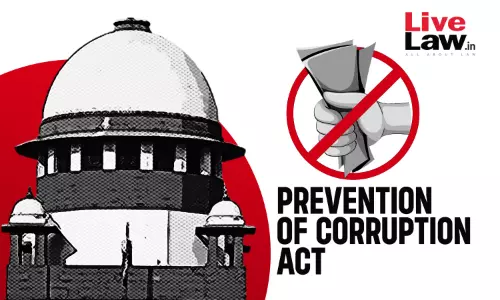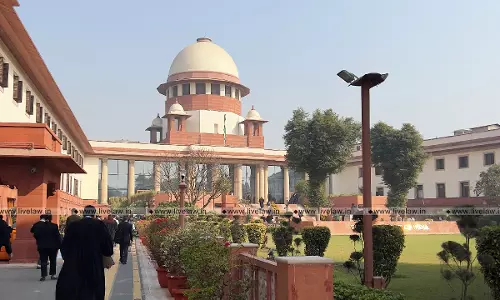53 Year old Rapist Killer of a 4year old Child is a menace to Society; SC send him to the gallows [Read the Judgment]
![53 Year old Rapist Killer of a 4year old Child is a menace to Society; SC send him to the gallows [Read the Judgment] 53 Year old Rapist Killer of a 4year old Child is a menace to Society; SC send him to the gallows [Read the Judgment]](https://www.livelaw.in/cms/wp-content/uploads/2014/05/DEATH-PENALTY.jpg)
"It is inconceivable from the perspective of the society that a married man aged about two scores and seven make a four year minor innocent girl child the prey of his lust and deliberately cause her death. A helpless and defenceless child gets raped and murdered because of the acquaintance of the appellant with the people of the society. This is not only betrayal of an individual trust...
"It is inconceivable from the perspective of the society that a married man aged about two scores and seven make a four year minor innocent girl child the prey of his lust and deliberately cause her death. A helpless and defenceless child gets raped and murdered because of the acquaintance of the appellant with the people of the society. This is not only betrayal of an individual trust but destruction and devastation of social trust. It is perversity in its enormity. It irrefragably invites the extreme abhorrence and indignation of the collective. It is an anathema to the social balance. In our view, it meets the test of rarest of the rare case and we unhesitatingly so hold" said the Supreme Court while upholding the death penalty awarded to a person who raped a four year old.
Vasanta Sampat Dupare had approached the Supreme Court after the death sentence awarded by Additional Sessions Judge, Nagpur for raping and causing death to a four-year-old girl was confirmed by the High Court. However, the Apex Court dismissed his appeal and maintained the death sentence.
The judgment delivered by a three judge bench consisting of Justices Dipak Misra, RF Nariman and UU Lalit starts by noting, 'In these two appeals, we are required to deal with a sordid and despicable act of a married man who, at the time of incident was in wedlock for more than two scores having a criminal background, has yielded not only to the inferior endowments of nature but also has exhibited the gratification of pervert lust and brutish carnality. The prey of such degradation and depravity was a minor girl aged about four years.' The judgment also notes, 'after satisfying his uncontrolled, insatiable and rapacious savage desire, battered the girl to death.'
Vasanta Sampat Dupare had taken the plea that he had been falsely implicated due to animosity. However, the Additional Sessions Judge, Nagpur awarded the death penalty after considering the evidence before the Court.
The appellant, before the Supreme Court that gross illegality was committed by the lower court and the High Court as they had placed reliance on the testimony of the parents of the deceased. It was also pleaded that the case is not a rarest of the rare.
The Supreme Court referred to the post mortem report of the victim and observed, 'it is clear as crystal that there was forcible sexual intercourse with the girl and the death was homicidal in nature.'
Regarding the cross examination of mother of the victim, Supreme Court said, 'It is apt to state here that nothing has been elicited in the cross-examination to raise any doubt about the veracity of her version.'
Supreme Court also referred to precedents on various aspects of the case, i.e. factors of discovery, ambit and scope of S. 27 of Evidence Act, seizure of clothes of the deceased etc.
The Court observed, 'in the present case the provision under Section 27 of Evidence Act is clearly attracted and we see no illegality in the seizure and the Panch witness have remained embedded in their version. Nothing has been suggested to disregard their evidence.'
The Court said, 'we find that each of the incriminating circumstances has been clearly established and the chain of circumstances are conclusive in nature to exclude any kind of hypothesis, but the one proposed to be proved, and lead to a definite conclusion that the crime was committed by the accused.'
The Supreme Court then affirmed the judgment passed by the trial Judge and affirmed by the High Court.
Regarding the aspect of sentence, relying on various precedents, the Court noted, We are absolutely conscious that mitigating circumstances are to be taken into consideration. Learned counsel for the appellant pointing out the mitigating circumstances would submit that the appellant is in his mid fifties and there is possibility of his reformation. Be it noted, the appellant was aged about forty-seven years at the time of commission of the crime. As is noticeable, there has been no remorse on the part of the appellant. There are cases when this Court has commuted the death sentence to life finding that the accused has expressed remorse or the crime was not pre-meditated. But the obtaining factual matrix when unfolded stage by stage would show the premeditation, the proclivity and the rapacious desire. Learned counsel would submit that the appellant had no criminal antecedents but we find that he was a history-sheeter and had number of cases are pending against him. That alone may not be sufficient. The appalling cruelty shown by him to the minor girl child is extremely shocking and it gets accentuated, when his age is taken into consideration. It was not committed underany mental stress or emotional disturbance and it is difficult to comprehend that he would not commit such acts and would be reformed or rehabilitated. As the circumstances would graphically depict, he would remain a menace to the society, for a defenceless child has become his prey. In our considered opinion, there are no mitigating circumstances.'
Finally, the Court said, 'we dismiss the criminal appeals preferred by the appellant and affirm the death sentence.'
You may read Live law's coverage on rape here.




